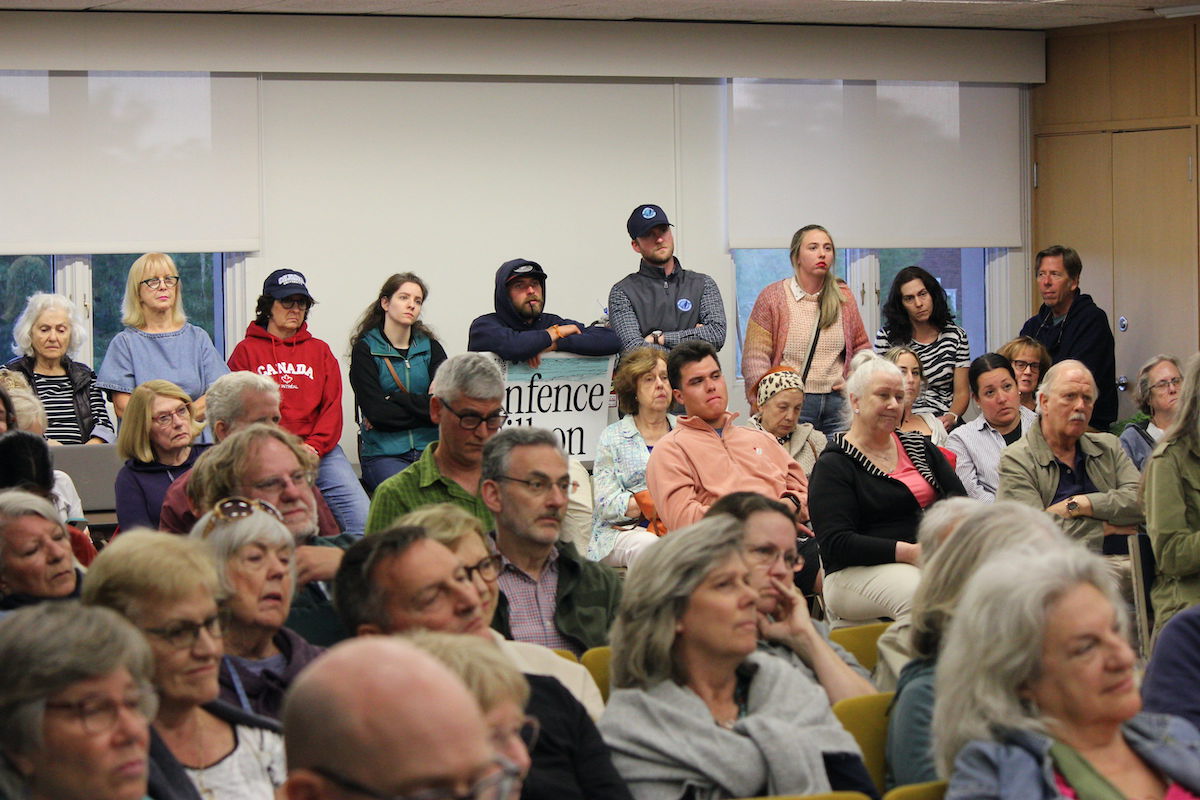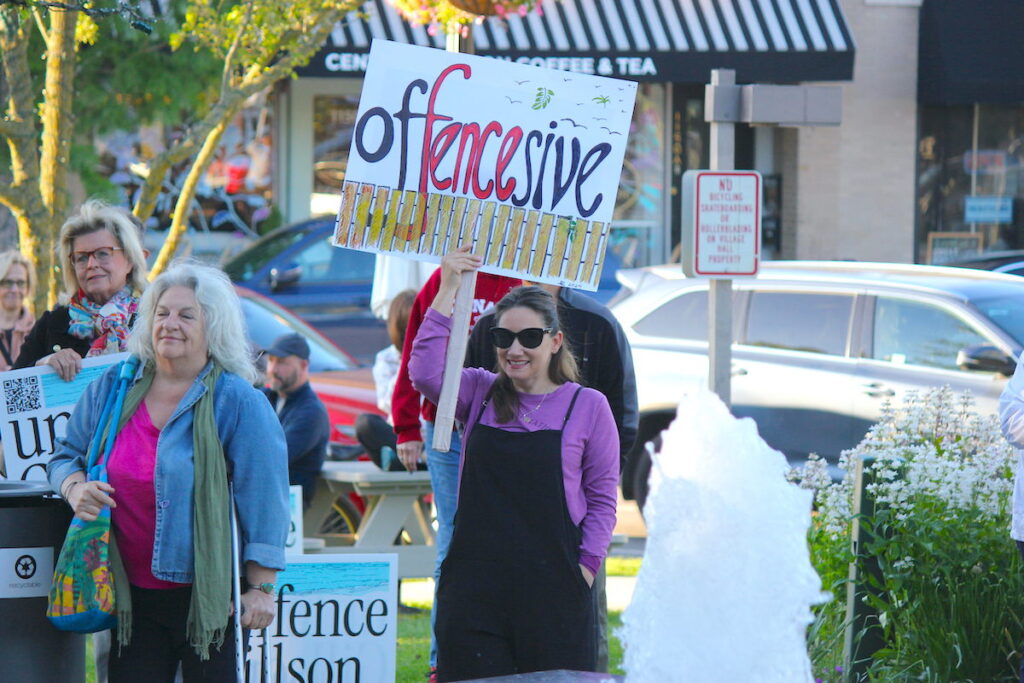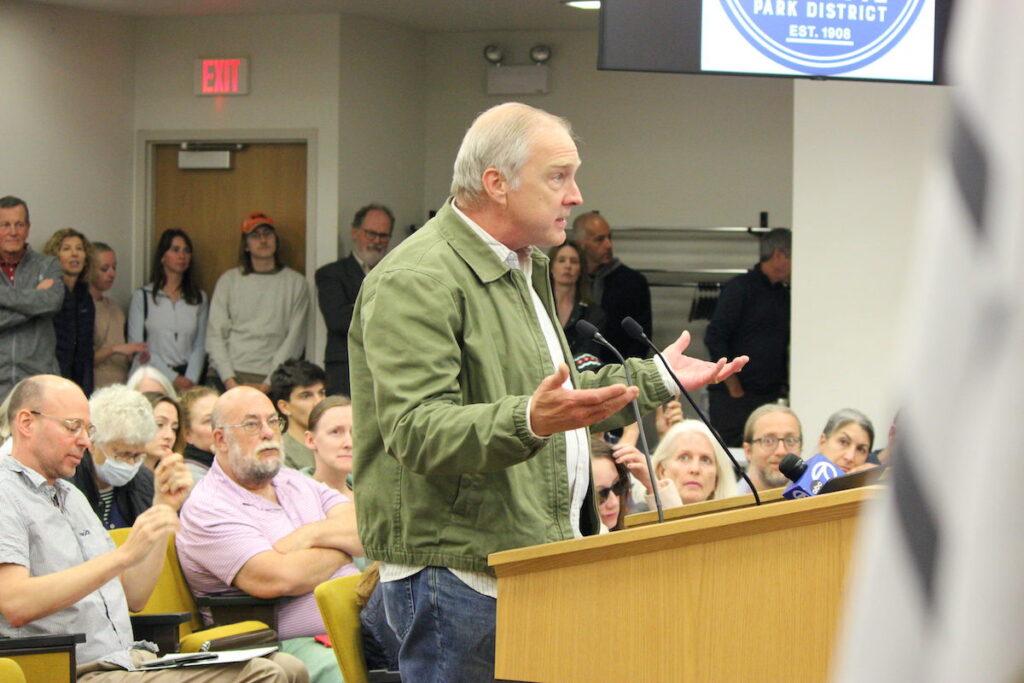
Frustrated residents let Park Board hear it over Gillson fencing; officials open to ‘alternative solutions’
Wilmette residents continued to shell out fierce opposition toward the park district’s updates, including a slatted fence, to Gillson Park’s South Beach during an evening full of mounting public criticism that continues to reach new heights.
Upward of 125 locals attended the Wilmette Park Board’s Monday, June 10 meeting to express their objection to South Beach’s new operations. Prior to the meeting, dozens of residents also rallied outside Wilmette Village Hall to contest the park district’s changes to the popular lakefront destination.
Park district officials have faced a wave of criticism for weeks over their decision to transition South Beach to a fee-based beach with a designated swim area. As part of the park’s changes, the district also in mid-May installed a slatted dune fence that surrounds the beach and limits access and entry points.
As first reported by The Record, park district officials announced their intentions to change procedures at South Beach during a mid-March committee of the whole meeting.
Park officials told commissioners earlier this year that the shift in operations would allow patrons to swim and include increased safety measures, such as lifeguards and security personnel and a daily entry fee of $5 for residents and $10 for nonresidents.
In announcing plans, park officials have continually cited years of ongoing and growing safety concerns, for both guests of the beach and park staffers, as the primary reasoning for the shift.

Following remarks from 39 locals — all but two of whom stated their disapproval to the updates, particularly the fencing — on June 10, Wilmette Park District Executive Director Steve Wilson offered what he described as a “little bit of history” on what led the park’s decision.
Wilson said that the idea to implement a swim beach with lifeguards at South Beach was first discussed internally between lakefront staff and district administration.
“The main thrust of that was to try and figure out how to address the consistent issue of patrons swimming, despite the signage and staff asking them to not swim, along with other rule violations, mainly the no swimming as well as alcohol consumption,” Wilson said during the meeting.
According to Wilson, park staffers often experienced challenges when enforcing the rules, and patrons reportedly became abusive and verbally aggressive toward them, he said. Staff would often have to involve Wilmette police to de-escalate situations, per Wilson.
“In the end, the lakefront and the administrative staff of the district were in agreement that something needed to be done before the conditions eroded further,” Wilson said.
The plan to implement a swim beach, he said, was presented to the park board, where it received unanimous support on April 9.
Since the fence
Several aspects of the park’s plans have drawn adamant opposition from locals, but the recently erected fence has proved to be a major point of contention.
Many have argued that the fence restricts access to the beach for mobility impaired patrons, limits attendance from out-of-town visitors, impacts safe passageways for wildlife, and restricts lakefront views from several locations along the beach.
Since the fence first went up in May, park officials have worked to make revisions to South Beach operations, according to Wilson.
Wilson told commissioners that the district has made “multiple modifications,” including “initially moving it back from the sidewalk a few feet because dog owners expressed the desire for the dogs to be able to walk there.”
The district also added a third entrance and exit point in the middle of South Beach and has “reconfigured a couple areas of the fence to try and improve the views from some of the benches along the sidewalk on Overlook Drive,” per Wilson.
Wilson concluded his remarks by saying that the first couple of weeks since the beach has opened under the new procedures have been “very smooth as reported by lakefront staff.”
“They’ve had significantly less conflict between patrons and staff,” Wilson said. “Management is not getting calls from staff on the south beach to come down and assist because of the situation and there have been no calls to the police.”
Per Wilson, the beach has been busy despite the early weather conditions. He said there have been more than 2,700 daily admissions, of which approximately 15 percent are Wilmette residents and 191 season pass visits thus far.
Beach fence ‘sends a message’

An 80-minute public comment session included remarks from just under 40 members of the public who brought up a host of their contentions toward the changes at South Beach.
Bill Loampouriats, a Wilmette resident for more than 30 years, said he was “stunned” by the park’s decision-making and urged the board to consider other options.
“This is a huge loss for the community,” he said. “It’s a huge loss for all of us. I strongly request that you reconsider this decision. Take a more measured approach, a more incremental approach and see how it goes. Let’s talk about other options and let’s try and find some middle ground here.”
Longtime Wilmette resident Jonathan Marshall told the board they’ve made “what has been a wonderful resource for the whole community” into one that people now have to pay to use.
“I think this is a great mistake that you all have made, and part of leadership is recognizing when you make a mistake and changing your mind,” he said.
Hanna Danecker echoed the comments of many residents by sharing that she previously considered Gillson Beach as a “place of solace, a refuge from the turmoils of modern life and a place to commune with nature.”
“Constructing a fence and enforcing fees enforces physical and economic barriers, cutting us off from nature, cutting us off from ourselves,” she said. “It transforms the once natural and symbiotic ecological and social relationships that occur in this space into a distinctly prohibitive and extractive dynamic.
“There are other viable solutions to the concerns reported by the Wilmette Park District as the reasons for implementing this fence. I implore Wilmette Park District to remove the fence and fees at Gillson Park South Beach and to consider all the alternative options.”
New Trier High School graduate Mandy Watson said that the fact that beach access is being restricted, particularly for non-Wilmette residents, is a social justice issue and a racial issue.
“Fencing off a previously free beach and having higher fees for nonresidents exacerbates existing inequalities that are rooted in society and Wilmette’s history,” she said.
“Putting up fences here sends a message that we don’t want outsiders coming to our beach. … The fences are setting a precedent of racial and economic exclusion and I believe that you, the park district, has a responsibility to maximize beach access to people who don’t have the privilege of living in Wilmette. You should be working toward minimizing barriers to beach access, not constructing barriers and fences, and support swim-at-your-own-risk policies.”
Rally and openness to ‘alternative solutions’
Prior to the start of the board’s meeting, locals gathered on the Village Hall Green to take part in a rally organized by Unfence Gillson, a local advocacy group. Many of the speakers who addressed the crowd during the rally also spoke during the meeting.
After public comment, Wilson told the public that the district has a shared interest to work with residents in developing “alternative solutions and ways to achieve the same outcome.”
“We’re open to that feedback,” Wilson said. “I’ve responded that way to just about every email. So, please, reach out to me. Those that (suggested) that tonight, I’m very interested to hear what you have to say. I look forward to that conversation.”
Commissioner and board Vice President Patrick Duffy, who led the meeting in the absence of Board President Kara Kosloskus, called the fence at South Beach “a temporary solution.”
The Record is a nonprofit, nonpartisan community newsroom that relies on reader support to fuel its independent local journalism.
Become a member of The Record to fund responsible news coverage for your community.
Already a member? You can make a tax-deductible donation at any time.

Martin Carlino
Martin Carlino is a co-founder and the senior editor who assigns and edits The Record stories, while also bylining articles every week. Martin is an experienced and award-winning education reporter who was the editor of The Northbrook Tower.


